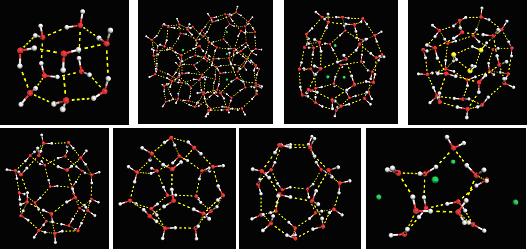Professor GUO Guangjun and his team research a basic problem about the growth of gas hydrates. They recently report a method called the face-saturated incomplete cage analysis (FSICA). The FSICA can identify all possible face-saturated cage compositions in a system and thus gives a complete picture of system evolution.
They use the method to re-analyze the nucleation trajectories previously reported by Walsh et al. with the purpose of verifying their conjecture that these nucleation trajectories actually reach the amorphous hydrate phase, which had not been well identified by the authors. The calculation of linking structures among all existing face-saturated cages leads to a quantitative description of the amorphous hydrate phase and enables us to conclude that the formed phase is still a long distance from the crystalline hydrate phase. Furthermore, clustering analysis for all face-saturated cages lets them estimate the critical nucleus of hydrate.

Fig. 1 Cage snapshots. (Image by GUO)
Guo et al. Using the face-saturated incomplete cage analysis to quantify the cage compositions and cage linking structures of amorphous phase hydrates. Phys. Chem. Chem. Phys., 2011, 13: 12048-12057 (Download Here)